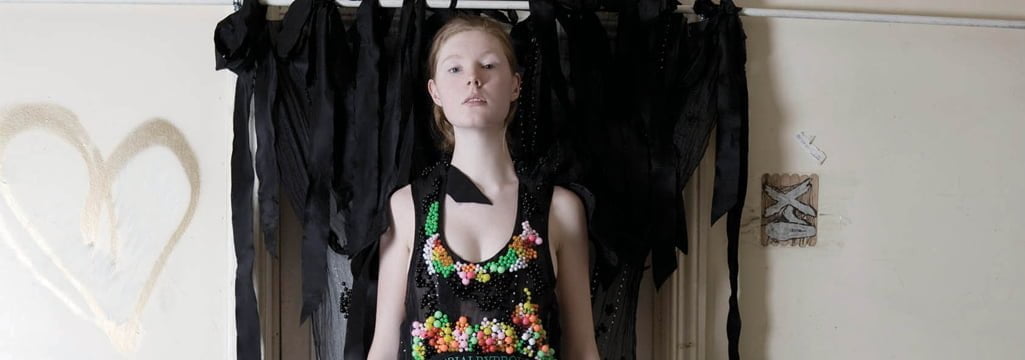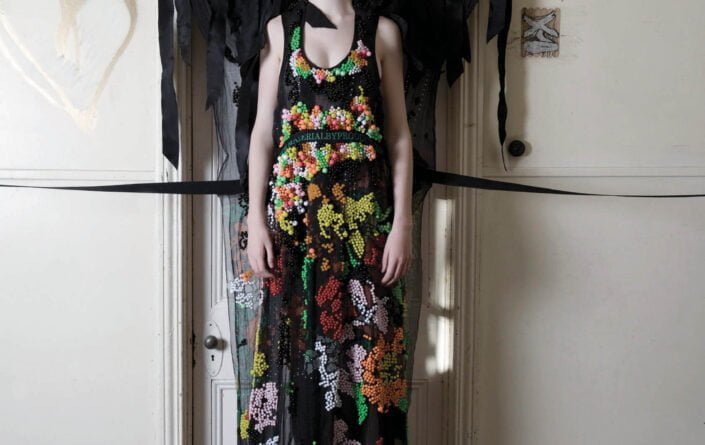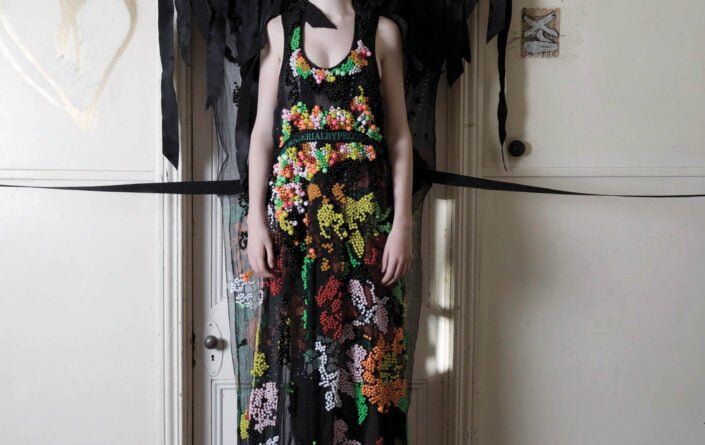MATERIALBYPRODUCT
(Susan Dimasi and Chantal McDonald)
Soft Hard Harder Dress Curtain is a culmination of ideas about technique and process. Through their label MATERIALBYPRODUCT (MBP), Susan Dimasi and Chantal McDonald have developed an entire design language. Dress Curtain uses MBP’s ‘dot system’, with its running lines of fine white circles on black fabric. The effect was at first applied by hand at the studio with liquid paper pens but is now printed offsite. With this system in place, little pattern making is needed as the dots have become design information – a language developed and spoken by the two designers through each collection. What Dimasi and McDonald call a ‘dumb blunt grid’ can be pulled apart for never ending retransformation. This idiom is routinely called on to solve design problems and to create an efficiency of cut and production.
With a deep understanding of haute couture methods and the differences with ready to wear, MBP continually try to limit the steps needed to produce a garment. Their collections seamlessly translate the artisanal register to the manufacturing one. Creating a procedural flow reduces time and waste, and, as the designers explain, “cutting and sewing is the most expensive part of production, that’s where the skills are and if it goes wrong there it will be wrong the way through”.
The first three years of production was spent rigorously inventing the MBP philosophy and working modes. With this thinking behind them, much of the planning work is done and increasingly, drawing or prototyping on the mannequin stand has become a way to solve new design problems. Now, the studio is a place where this language is consolidated and ‘talked’ with scissors, chalk and thread.
2008(Susan Dimasi and Chantal McDonald)
Soft Hard Harder Dress Curtain is a culmination of ideas about technique and process. Through their label MATERIALBYPRODUCT (MBP), Susan Dimasi and Chantal McDonald have developed an entire design language. Dress Curtain uses MBP’s ‘dot system’, with its running lines of fine white circles on black fabric. The effect was at first applied by hand at the studio with liquid paper pens but is now printed offsite. With this system in place, little pattern making is needed as the dots have become design information – a language developed and spoken by the two designers through each collection. What Dimasi and McDonald call a ‘dumb blunt grid’ can be pulled apart for never ending retransformation. This idiom is routinely called on to solve design problems and to create an efficiency of cut and production.
With a deep understanding of haute couture methods and the differences with ready to wear, MBP continually try to limit the steps needed to produce a garment. Their collections seamlessly translate the artisanal register to the manufacturing one. Creating a procedural flow reduces time and waste, and, as the designers explain, “cutting and sewing is the most expensive part of production, that’s where the skills are and if it goes wrong there it will be wrong the way through”.
The first three years of production was spent rigorously inventing the MBP philosophy and working modes. With this thinking behind them, much of the planning work is done and increasingly, drawing or prototyping on the mannequin stand has become a way to solve new design problems. Now, the studio is a place where this language is consolidated and ‘talked’ with scissors, chalk and thread.
2008



